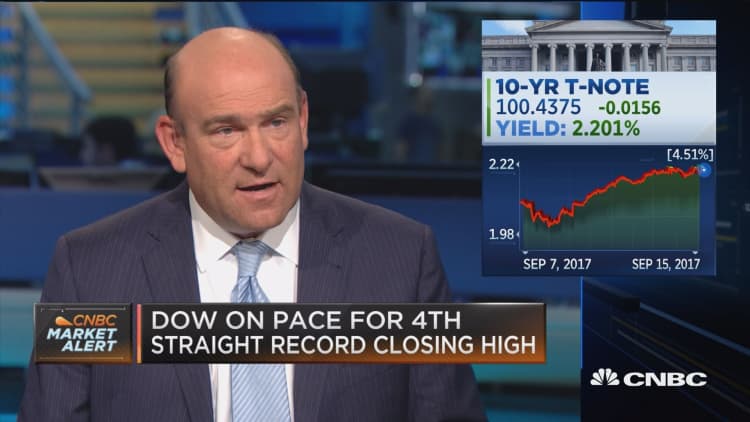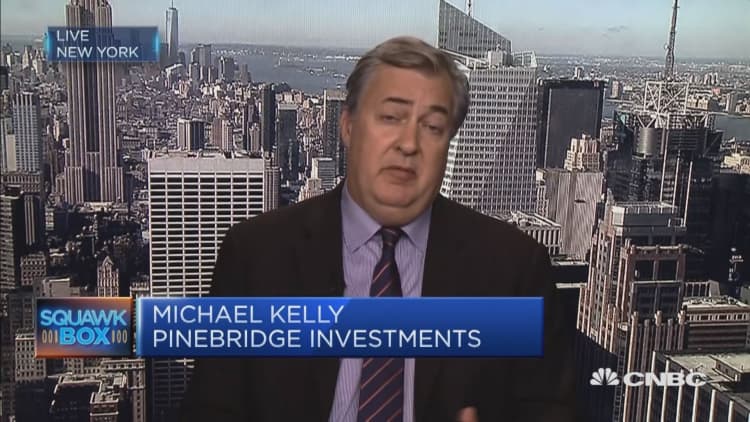
Next week's Fed meeting will have a lot of moving parts: a decision on whether to hike rates, the likely beginning of the balance sheet unwinding and an update on how economic growth is likely to trend.
One factor, though, could stand out: The so-called dot plot, which charts where individual Fed members expect interest rates to be over the next few years. Policymakers update the chart every quarter, and market participants watch it closely for expectations on monetary policy.
Until recently, the market thought it had the Fed figured out. With economic growth stable, the unemployment rate continuing to come down and inflation trending toward the 2 percent target, the Fed likely would continue on a path of steady, gradual rate increases.
However, recent statements from officials indicating that inflation may stay under the Fed's target rate for longer than they thought has kindled curiosity about what that will mean for the rate trajectory.
"What will move the market more is if the dots on the dot plot start to come down," said Jim Caron, fixed income portfolio manager at Morgan Stanley Investment Management.
Here's what the dot plot looked like after the June meeting. Note that there are four projections — for the years 2017-19, and then for the longer run. Each dot represents a member of the Federal Open Market Committee, which sets monetary policy. Twelve members vote, though all committee members get a dot:
Source: Federal Reserve
Like many Fed watchers, Caron indeed is expecting the path to move downward. That would reflect a feeling that rates won't be going up as much as the Fed believes. Current projections have the benchmark funds rate hitting 3 percent in 2019, a measure that also is considered the "long-run" rate that would be neither stimulative nor restrictive.
"I don't believe that," Caron said. "If the Fed starts to say the 3 percent terminal rate is too much and we move long term to 2.75 percent, that's going to have more of an impact on the yield curve, create more of a flattening bias."
Typically, a flatter yield curve arises from lowering expectations on the economy. In this case, it likely will be more of a reflection on where the Fed thinks inflation is going.
Under its dual mandate, the Fed is charged with maintaining full employment and price stability. Part of that entails a 2 percent inflation rate that officials believe promotes a healthy level of growth but not so much that buying power is sapped significantly.
Earlier this week, anticipation grew that the Fed might approve a rate hike at the December meeting because the consumer price index rose to a 1.9 percent annualized rate. The current probability of a hike then is 57.5 percent, up sharply from just 31 percent a week ago, according to the CME.
There are two problems with that: The Fed's preferred measure of inflation is the personal consumption expenditures index, and that was up 1.4 percent most recently. And even if the Fed did put more stock in the CPI, that's just one month's reading and likely to be viewed as unconvincing.
"We've had one good CPI number. That's one in a row," Caron said. "We've had a lot of bad ones, too."
Investors may get some more clues elsewhere about the future of policy.
The FOMC is highly unlikely to do anything with rates at this meeting, but it could tip its hand in the post-meeting statement. In addition, Chair Janet Yellen has a post-meeting news conference during which she no doubt will face questions about inflation and the projected future path of rates.
Also at the meeting, the committee is expected to announce the beginning of its balance sheet roll-off, a process that will begin reversing the stimulus the Fed provided during and after the financial crisis. The Fed's balance sheet currently stands at $4.5 trillion.
One wild card in all of the permutations is that the committee likely will look a good deal different by early 2018. Yellen's term expires in 2018 and President Donald Trump could end up filling five of the seven Fed governorships.
Josh Wright, chief economist with iCIMS, said he expects the 2017 dot plot to remain basically unchanged, though three members — Charles Evans, Patrick Harker and Robert Kaplan — are likely to reduce their forecasts.
"The median dots for 2018 and 2019 are unlikely to move more than the 2017 dots. It will be interesting to see how their dispersion shifts, but the uncertainty associated with the pending Fed appointments makes the dot plot less useful as guidance for 2018 and 2019," Wright said in a note.
WATCH: Fed-watchers also will be keeping on eye on the $4.5 trillion balance sheet.



